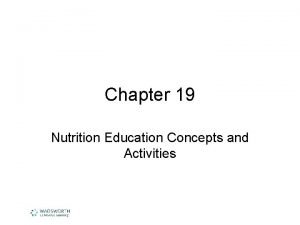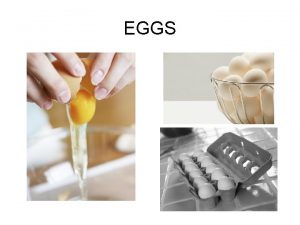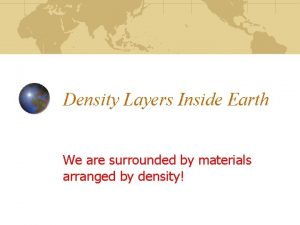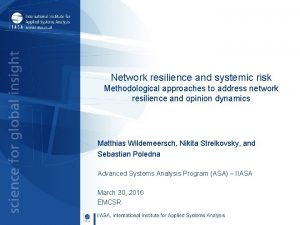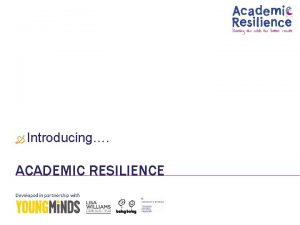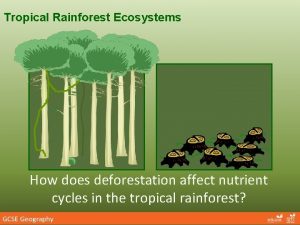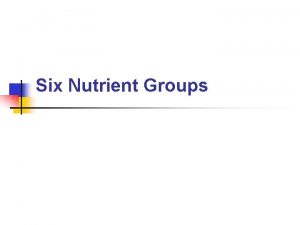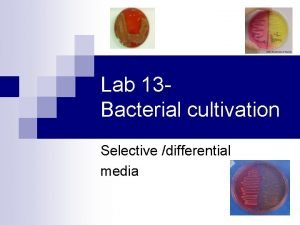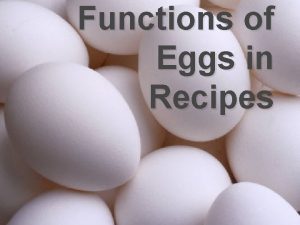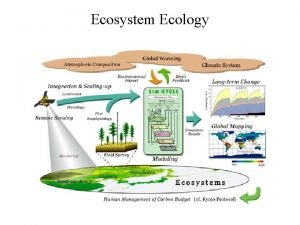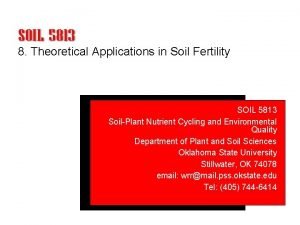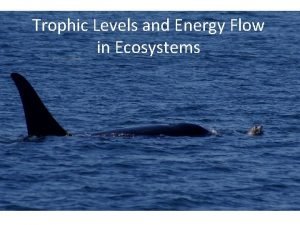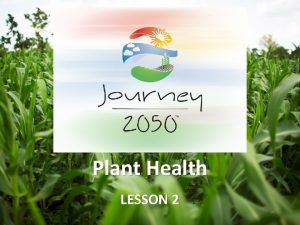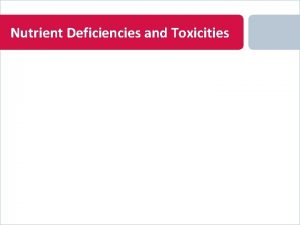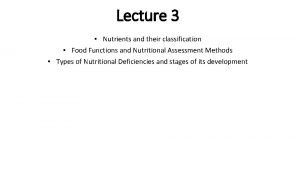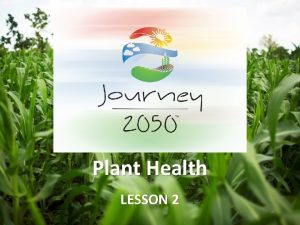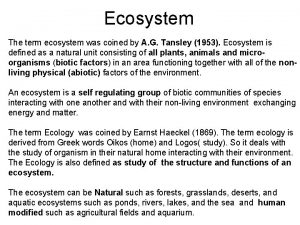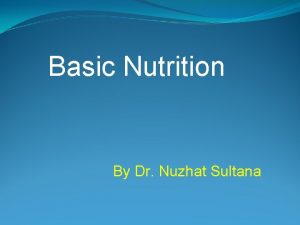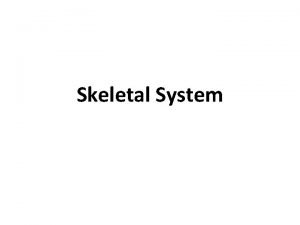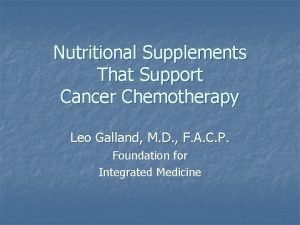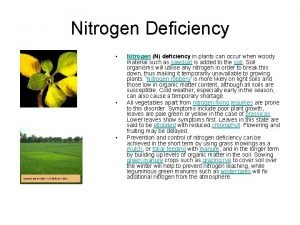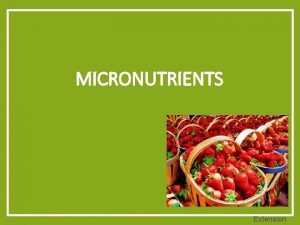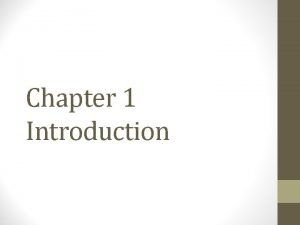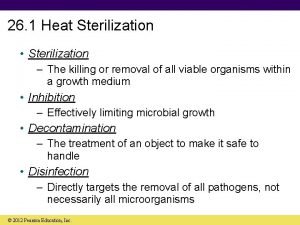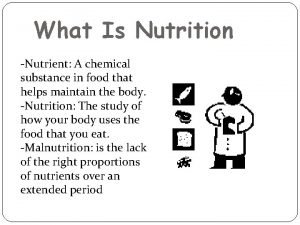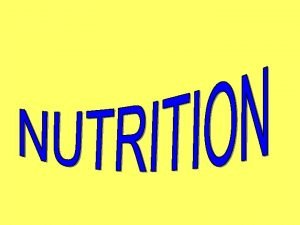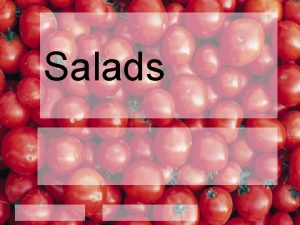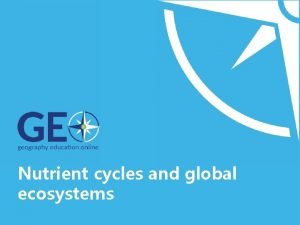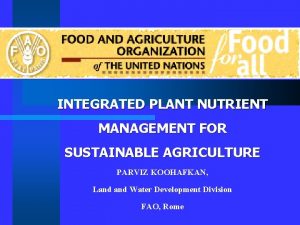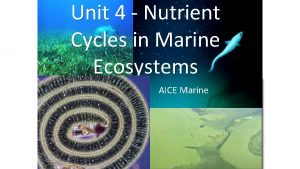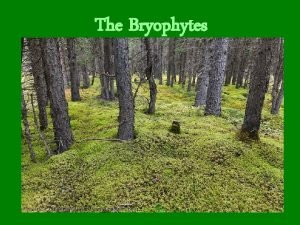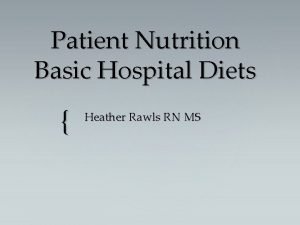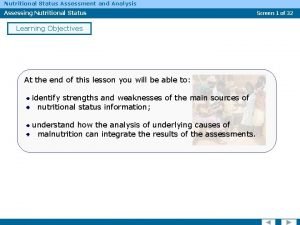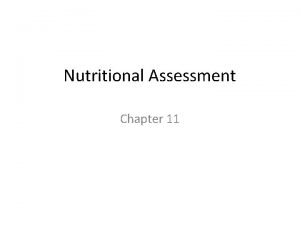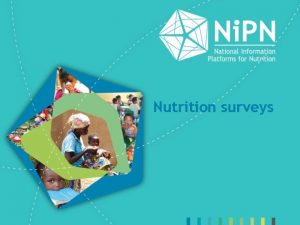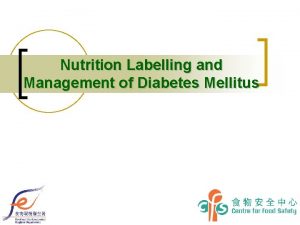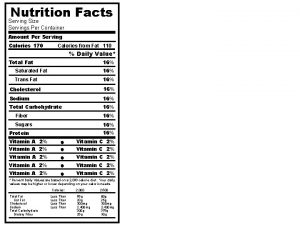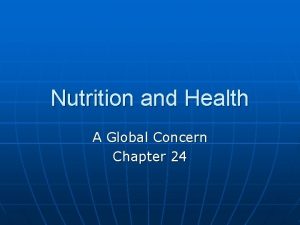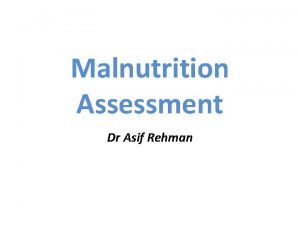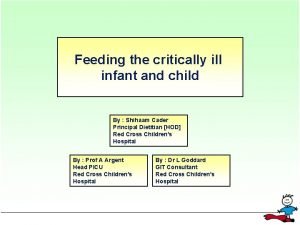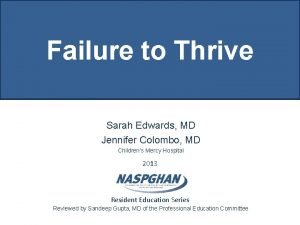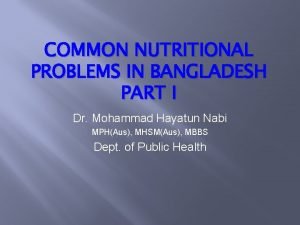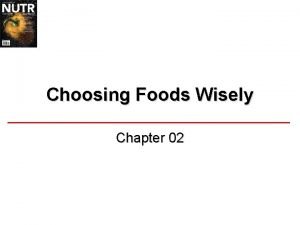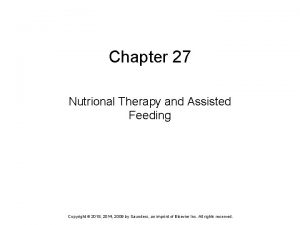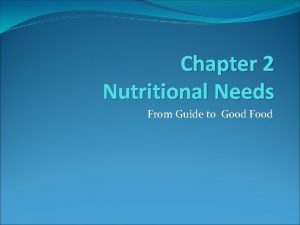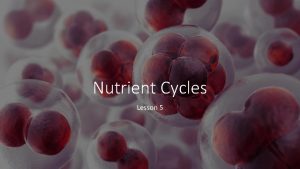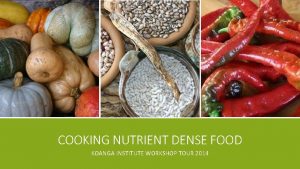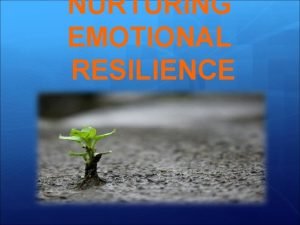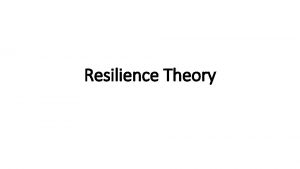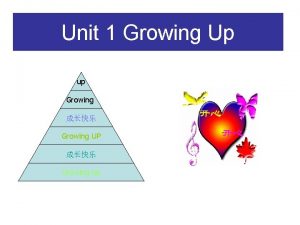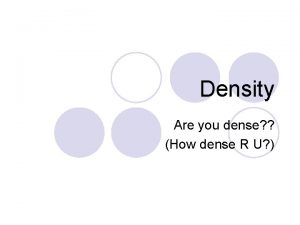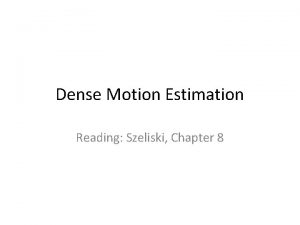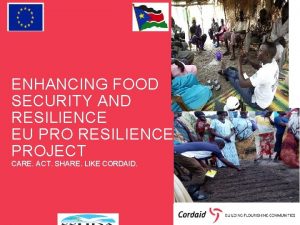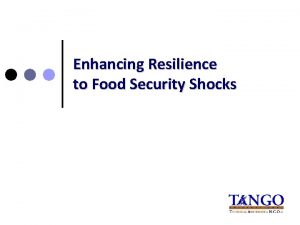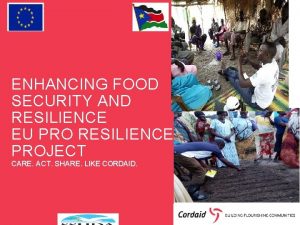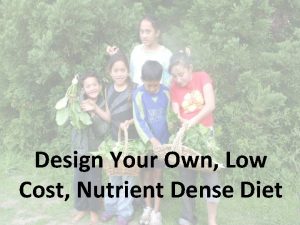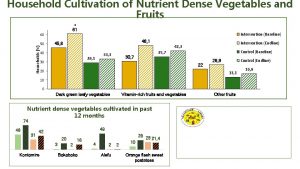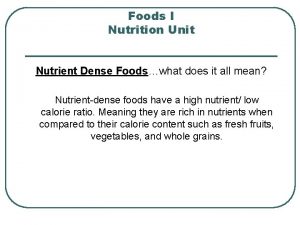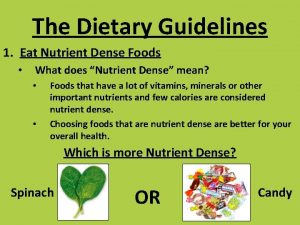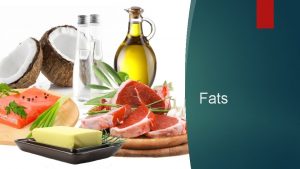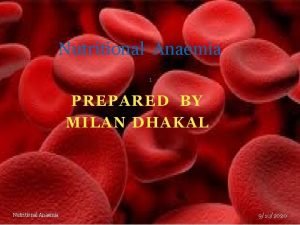Growing Nutrient Dense Food The nutritional resilience approach




































































- Slides: 68

Growing Nutrient Dense Food The nutritional resilience approach to food security

Weston Price spent 20 years researching the diet and health of indigenous people’s eating traditional diets • • • 90% loss of fat soluble vitamins ! 75% loss of major minerals ( calcium etc) By 1920, is only getting worse since then

• Weston Price came to the conclusion that there is a direct link between nutrition and human health, physical health, mental health and emotional health. • He understood that to maintain our health we needed to follow the diet principles of all indigenous peoples. • That means we need to find ways to increase our fat soluble vitamin intake x 10 and our mineral intake x 4 at least… • For more info see Nutrition and Physical Degeneration : Weston A Price.

• In 1992 at the Earth Summit it was confirmed that soils on a global level had lost 75% of the minerals they had held in relatively recent times. • In the U. S. 85% of the minerals were gone.

• According to a 150 page report entitled Diet, Nutrition and Prevention of Chronic Disease, which can be viewed on line at W. H. O. website… • A majority of people in the ‘developed’ world are suffering from Type B malnutrition. The research revealed a nutritional link to every disease studied.

• The International Journal of Biosocial Research cites numerous examples of single nutrient deficiencies which have contributed to diminished mental capacity, mental emotional disorders, behavioural disorders, eating disorders, drug and alcohol addiction, autism and violence.

Epigenetics Environment Determines Genetic Expression we now understand that the quaity and levels of vitamins minerals and fatty acids in our fod is what communicates withg ourt ‘junk DNA’ and that the qualuty f that communication is what determines the tags placed omn our DNA which detremines how our DNA expresses and how DNA in future generatons expresses. . We now know we can turn thngs aroun dby changing the environment ie food we eat thoughts we think etc

• New Zealand Soils are 600 million years younger than the soils that our food plants co-evolved in… we have soils that grow ferns and mosses and our native bush. Over millions of years the soils and vegetation go through a process of co evolution. . Soil evolves as plants bring in nutrients from universe…. Plants evolve • our job is to create soil in the image of the soils our food plants co-evolved in. . Our job is to speed up the process of soil building whilst following the laws of nature around how healthy soils grow

• In 1978 Bill Mollison and David Holmgren developed a design methodology which gives us a way of making intelligent decisions to find solutions to our current predicament based on the Ethics of all indigenous people, and the principles and patterns found in nature. It’s called Permaculture Design!

Permaculture conscious design of human systems that mimic nature.

Understanding the Principles or ‘Laws of Nature’? My teachers have been and still are; Ardern Anderson Dr Carey Reams A. F. Beddoe (Nourishment Home Grown) Biological Movement around the world but specifically USA and NZ and Australia Graham Sait Nutritech Solutions Acres USA Grant Paton Enviromental fertilsers Phyllis Tichinan Abron


Nourishment Home Grown AF Beddoe • Creation is the putting together of light/energy into matter. • If we study this we discover how healthy cells can be built in plants, animals or humans and how to supply that healthy cell with the energy needed to sustain it on it’s frequency in a best functioning condition. • Once we know that we can co operate with nature/creation through laws/patterns that build healthy productive gardens, farms and body temples!

• The fundamental building blocks are the basic atomic elements as described by traditional science in the Periodic Tables. • These elements combine to form various molecular structures that make up all biologic life. • These elements all have certain chemical, physical and electromagnetic properties. • These properties are expressions of energy that are contained within the atoms of these minerals.

• This energy is available and exchangeable in the growth process of plants and animals (and humans!).

• The plant uses 84 different minerals. When any of these are missing or in short supply, or when something interferes with it’s proper uptake, or combining into organic plant structure, the plant will begin to experience deficiency. • If the deficiency is prolonged or severe enough, the symptoms will manifest as plant disease or insect problems.

• The true measure of the mineral supply coming from the soil is the sugar content of the juice of those plants. • This concentration of sugars, vitamins, minerals, amino acids, proteins, hormones, and other solids dissolved within the juice is measured in BRIX ( ratio of the mass of dissolved solids to water) and the same method can be used to determine the nutritional density of most foods, and the sap of plants. • When plants are grown in soil with balanced and high fertility, the BRIX reading of the plant sap and juice of the produce is significantly higher than the same plant grown in less than ideal conditions

Carbon The Moisture Regulator: Humus holding minerals and water

• Carbon can hold 4 x it’s weight in water. • The lower the carbon the less water can be applied at a time. • Carbon forms the basis of your soil’s mineral energy savings account. It holds onto soil nutrients until plant roots can use them both before and after bacteria work on them. Ideal level is 10% soil weight.

Nature Follows the Line of Least Resistance • The greater the mineral content in the top soil, the less the resistance in that soil and the greater likelihood the current will stay flowing in the soil. The greater the mineral content within a plant, the easier it will be for the plant t have electric current flowing in it. • It will have better magnetism or attraction for more mineral energy. Therefore the plant will draw in more electromagnetic energy and be a top quality plant in every aspect.

The Importance of Calcium • Calcium is used by weight and volume more than any other mineral element. The result of all the functions of calcium is the manufacture of amino acids for the making of plant protein and human food. • Thus the more calcium that is transported into the plant, the greater the plant’s ability to attract nutrients out of the air- chiefly carbon dioxide, nitrogen, potassium and magnesium.

7: 1 • available calcium and available magnesium need to be in a ratio of 7: 1 • Calcium is the most critical mineral, and the one that is most likley to be missing • Levels not as critical as ratio

Phosphate Controls Sugar Content

• Phosphate, the phosphorous-oxygen complex, is the carrier of the mineral from soil to plant, also the catalyst in the sugar making process, called photosynthesis, that takes place in the leaf of the plant. • Water and oxygen are brought together in the chloroplast during the heat of the day to make crude sugar. Phosphate is the catalyst for the process. The mineral elements carried in the phosphate, are left behind when sugar is formed. This is why the higher the sugar, the higher the mineral content.

1: 1 • Available phosphorous: potash ratio 1: 1 garden and pasture 2: 1 • Implications of not having phosphate in the soil. . Minerals go into plant in nitrate form, low brix, low level carcinogenic • Phosphorous usually low, or locked up • Phosphate is like the usher at the wedding, • Implications of phosphorous not being used up in photosynthesis process. .

Getting The Ratios Right! • The plant uses 84 different minerals. When any of these are missing or in short supply, or when something interferes with it’s proper uptake, or combining into organic plant structure, the plant will begin to experience deficiency. • If the deficiency is prolonged or severe enough, the symptoms will manifest as plant disease or insect problems.

Energy Release • Plants live off the energy release from the elements interacting as the elements synchronise in ionic molecular form in the soil. The interaction of the minerals within the soil solution is similar to the reaction seen when putting vinegar and baking soda together.

• Out of these basic understandings (principles, Laws of Nature ) we can begin to see patterns in or natural world which can then become the base upon which we build our strategies and tecniques.

Crop Health Transitions

Stage 1 • Adequate sunlight, air, water, and the right minerals in the right relationships, creates an efficient photosynthesis process where plants absorb carbon dioxide from air, water from the soil and with energy input from the sun begin producing plant sugars. . Carbs! • Initially simple sugars, monosaccarides, frutose, glucose and dextrose.

• As this process evolves, more complex sugar, polysaccarides, begin to develop. Cellulose, lignin, pectins, and starches which are structural and storage carbohydrates and they are produced in greater quantities as plants become healthier. • ‘Pathogens’ alternaria, fusarium and verticillum cease to be a problem at stage 1.

Stage 2 • As photosynthetic energy increases plants begin to transfer greater quantities of sugars to root system and to the microbial community in the rhizosphere. • This will stimulate them to mineralise and release minerals and trace minerals from the plant matrix in a plant soluble form.

• Plants then utilize these essential minerals as enzyme co factors which are needed to form complete carbohydrates and especially proteins • Soluble sugars, monosaccarides, when partnered with nitrogen are base materials used to form amino acids, - insect food • Through the action of enzyme catalysts, these amino acids are bonded together to form peptides, from which complete proteins are formed • Stage 2 gives plants resistance to larval insects, corn earworm, cabbage loopers and leaf miners

Stage 3 • As photosynthetic energy efficiency increases plants develop a surplus of energy beyond that needed for basic growth and reproduction of which up to 70% is translocated to the root system • Next the plants begin to store this surplus energy in the form of lipids ( plant fats) in both vegetative and reproductive tissue: . vegetative omega 3 reproductive omega 6

• Lipids are needed to form the phospho lipid cell membrane. As lipid levels increase, the membrane becomes stronger and more resilient and more resistant to fungal pathogens, mildew, blight, scab, rust, fire blight and bacterial spot. • This will not happen without a functional rhizosphere

• Stage 4 • Elevated lipid levels are then used to build complex plant protectant compounds, essential oils for protection from climate change, UV radiation, insects and herbivores. • These compounds are called terpenoides, bioflavanoids, carotenes, tannins and they contain anti fungal and anti bacterial properties as well as digestive ( ezyme) inhibitors • Once plants reach stage 4 they become immune to insect attack, beetles etc • Based on an article by John Kempf of Advanced Agriculture Middle field Ohio

Where to from here? • Back to our Ethics Principles Patterns Strategies and Techniques to design our way to a solution

• So we’ve learned a few principles, perhaps some of the key ones, we’re on the journey… • Time to enter a design process and use everything we know to create some sensible strategies for our situation based on an understanding of the principles involved and a knowledge of the local patterns involved

It All Comes Down To The Minerals and the Microbes • The more we can hold carbon in the soil and get the minerals in the right relationships, the more potential there is for interactions for both the building up and breaking down of mineral compounds, the more microbes we can feed and the more energy there is released that is available for plant growth

BRIX-Nutrient Density • The true measure of the mineral supply coming from the soil is the sugar content of the juice of those plants. • This concentration of sugars, vitamins, minerals, amino acids, proteins, hormones, and other solids dissolved within the juice is measured in BRIX ( ratio of the mass of dissolved solids to water) and the same method can be used to determine the nutritional density of most foods, and the sap of plants. • When plants are grown in soil with balanced and high fertility, the BRIX reading of the plant sap and juice of the produce is significantly higher than the same plant grown in less than ideal conditions

Step 1 Learn to use a refractometer • Regular times during day eg 1: 00 after lunch • once a week minimum • Always rub for same length of time ( around 2 minutes) • Always pick leaves from the same place on plant and from several plants • Note weather • Check for sharp or blurry line • Check again ½ - 2 hours after applying minerals • Keep good records

Step 2 Understanding the physical properties, (the patterns) of your soil • V. S. A. soil assessment guide Soil tests Reams ( what’s available to plant roots), Bio Services Hill Laboratories ( what’s available in the soil) • Healthy Soils


Step 3 Create 50% air space in your soil for strong root and anaerobic microbe growth • Strategies • Techniques-

Step 4 after creating air space create ideal or as close to, moisture levels to achieve excellent root and microbe growth • Strategies: increase humus , carbon levels, irrigation • Techniques:

Step 5 achieve high levels of carbon and humus to hold water and minerals Strategies: composting, Biointensive, Food Forests, Biodynamics, , foliar feeding, remineralisation /appropriate fertilser, holistic management Techniques Carbon crops Humus Builder Biochar Chop and drop Agnihotra 18 day Berkley

Step 6 Right Minerals in Right Relationships …. . if we use low brix material to make our compost we are recycling the deficiencies. . won’t grow high brix food……. Strategies (Transition/ sustaining) • • • Blocking the leaks Composting Forest gardening Returning humanure Bringing in fert Learn to make our own fertilisers Using plants to minerals

Techniques * Buy fertilser based on • • • • Reams soil tests, and principles Mineralised worm farms Harvest biomass from one area to improve another Choose specific crops to balance your mineral needs 7 layers in forest garden Add minerals to compost Burn bones shells add ash to compost Make biochar with bones shells Use high brix compost ingredients Salt Water Recipes Gil Karangdang humanure Milk Leaf Mould agnihotra Seaweed, liquid seaweed Animal manure
















Step 7 Support Strong Active Microbe populations Patterns: understand your own soil microbe patterns Strategies: increasing carbon, balancing minerals, applying microbes, Techniques • • Compost tea Compost Seedling innoculant Biopesticide Vermicast BD 500 BD Cow Pat Pit Raw Milk

Attach to this power point compost tea instructions, Also a link to the Unconventional Farmer website Refractometer instructions Recommended reading Nourishment Home Grown Growing Nutrient Dense Food Ecology Action Composting Ecology Action Future fertility Ecology Action Grow Your Own Fertilser Design Your own Forest Garden Koanga Garden Guide



 Example of complex media
Example of complex media Foods used in nutrition activities should be nutrient-dense
Foods used in nutrition activities should be nutrient-dense Interfering agent eggs
Interfering agent eggs What are the 3 main layers of the earth? *
What are the 3 main layers of the earth? * Earth's layers most dense to least dense
Earth's layers most dense to least dense The earth's layers foldable
The earth's layers foldable Network resilience a systematic approach
Network resilience a systematic approach Academic resilience approach
Academic resilience approach As nutritional energy passes through the food chain, energy
As nutritional energy passes through the food chain, energy Unit 2 food food food
Unit 2 food food food Grazing food chain diagram
Grazing food chain diagram Veins of upper limbs
Veins of upper limbs How does deforestation affect the nutrient cycle
How does deforestation affect the nutrient cycle Nnn plant protein
Nnn plant protein Non fastidious definition microbiology
Non fastidious definition microbiology Emulsifier egg recipes
Emulsifier egg recipes Nutrient cycle in the serengeti
Nutrient cycle in the serengeti Deciduous woodlands
Deciduous woodlands Bray nutrient mobility concept
Bray nutrient mobility concept Energy in trophic levels
Energy in trophic levels Which nutrient practice was best journey 2050
Which nutrient practice was best journey 2050 Chlorsis
Chlorsis Nutrient basics
Nutrient basics Classification of nutrients and their functions
Classification of nutrients and their functions Journey 2050 student handout 3 crossword puzzle
Journey 2050 student handout 3 crossword puzzle Ecosystem term coined by
Ecosystem term coined by Nutrition defination
Nutrition defination Biogeochemical cycles apes
Biogeochemical cycles apes Iliac nerve
Iliac nerve Nutrient artery
Nutrient artery Tamoxifen nutrient depletion
Tamoxifen nutrient depletion Nutrient deficiency in tomatoes
Nutrient deficiency in tomatoes Nutrient interactions
Nutrient interactions Immobile nutrients
Immobile nutrients Nutrient agar plate
Nutrient agar plate Chemical substance in food that helps maintain the body
Chemical substance in food that helps maintain the body A chemical substance in food that helps maintain the body
A chemical substance in food that helps maintain the body A main dish salad must contain which nutrient
A main dish salad must contain which nutrient Nutrient cyle
Nutrient cyle Integrated nutrient management for sustainable agriculture
Integrated nutrient management for sustainable agriculture Nutrient cycles in marine ecosystems
Nutrient cycles in marine ecosystems What nutrient cushions vital organs
What nutrient cushions vital organs Nutrient chain foldable
Nutrient chain foldable Virtual circuit vs datagram
Virtual circuit vs datagram Theoretical models of counseling
Theoretical models of counseling International market selection model
International market selection model Multiple approach avoidance conflict
Multiple approach avoidance conflict Cognitive approach vs behavioral approach
Cognitive approach vs behavioral approach Definition of research approach
Definition of research approach Approach to system development
Approach to system development Deep learning approach and surface learning approach
Deep learning approach and surface learning approach Valoarea calorica a alimentelor
Valoarea calorica a alimentelor Nonvascular plants phylum name
Nonvascular plants phylum name Abcd of nutritional assessment
Abcd of nutritional assessment Nutritional status assessment
Nutritional status assessment Nutrition epidemiology definition
Nutrition epidemiology definition Optimal nutritional status
Optimal nutritional status Types of nutritional survey
Types of nutritional survey Nutritional management of diabetes mellitus
Nutritional management of diabetes mellitus Servings per container
Servings per container Chapter 24 nutritional care and support
Chapter 24 nutritional care and support Types of malnutrition
Types of malnutrition Major nutritional deficiency diseases in emergencies
Major nutritional deficiency diseases in emergencies Abcd of nutritional assessment
Abcd of nutritional assessment Ftt criteria
Ftt criteria Major nutritional problems in bangladesh
Major nutritional problems in bangladesh Abcd of nutritional assessment
Abcd of nutritional assessment Chapter 27 nutritional therapy and assisted feeding
Chapter 27 nutritional therapy and assisted feeding Chapter 2 nutritional needs
Chapter 2 nutritional needs

